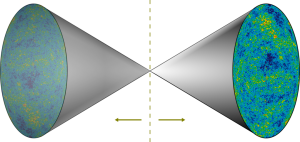
The particles that make up the Universe around us are out of balance, and physicists are searching for a cause.
Following the Big Bang, there should have been an equal number of particles that mirror one-another. I.e. there should be just as much antimatter in the universe as there is regular matter, but this does not appear to be the case. The question is, where did the particles that account for this imbalance go?
One team of theoretical physicists thinks that the missing particles might be in a mirror universe that exists simultaneously to our own, but is made up of antimatter which runs backward in time.
This theoretical balance that our universe’s particles are expected to be in is represented by the concept of “CPT symmetry”, a theory that posits that three fundamental properties within particle physics, charge (C), parity (P) and time (T) could be reversed and the outcome of whatever process is being observed will remain the same:
Charge represents the polarity of a particle, for instance the negative charge of an electron; in this symmetry the charge of the particles in any given interaction can be swapped and they should still interact the same way as their mirror counterparts would. As an example, ordinary electrons (-) and protons (+) attract one-another because of their opposite charge; swap their polarities, as it would be with their antimatter counterparts, and the two, now a positron and antiproton, still attract one-another because they still have opposing charges.
Parity is the physical orientation of a particle, for instance whether it spins to the left or the right. Theoretically, these spins shouldn’t affect the interactions between particles; using the above example between an electron and proton, antimatter particles have both their charge and spin reversed, and yet should still interact with one-another in the same way that their regular counterparts do.
Time symmetry means that these interactions between particles are identical regardless of which direction in time they occur. For instance, a photon striking the nucleus of an atom should produce an electron and positron; colliding this electron/positron pair back into that same nucleus will produce a photon.
For the most part, the vast majority of the particles that make up the universe follow these rules, but there are a handful of ones that don’t; for instance, the majority of the universe’s neutrinos exhibit a left-hand spin, with very few right-hand-spin neutrinos to be found; also, our universe seems to be missing most of the antimatter that should exist to balance out regular matter. But where are these missing particles that keep our universe in balance?
All of these missing particles might reside in another universe, one that mirrors our own, according to Neil Turok, a physicist with Canada’s Perimeter Institute for Theoretical Physics. Turok proposes that when the Big Bang occurred nearly 14 billion years ago, it birthed not only our universe but a mirror universe made up of antimatter (particles with charges and spins opposite to regular matter) that runs backward in time. Because the particles that exist in that universe are the mirrored counterparts to our own they should follow all the physical laws that we are familiar with, in turn creating a universe that would have unfolded in a manner very similar to ours.
Turok says that he doesn’t expect that such a universe would precisely mirror our own, but have variations that would allow one to distinguish between the two. He says that one can also calculate the abundance of certain mirror particles, such as the illusive right-hand-spin neutrino: using the observed density of dark matter—of which might also reside in this mirror universe—the right-hand neutrino would have a mass of about 500 million times that of a proton.
This mass, 5×10∧8 billion electron volts (GeV), is also extremely similar to the mass of two neutrinos that passed through the Earth in 2006 and 2014 that Turok says might have come from a parallel universe: the probability of one ordinary neutrino passing though the Earth without colliding with one of the particles that make up the planet is remote enough, but such an event was recorded as having happened at least twice within eight years. But if these particles were from a mirror universe they could very well have passed through the planet unimpeded, and popped out into our universe just in time to collide with the IceCube Neutrino Observatory’s sensors.
Turok admits that his idea isn’t perfect: for instance, this model would require its right-handed neutrinos to be completely stable and not decay as left-handed ones are wont, so the theory is a work in progress. “It is possible to make these particles decay over the age of the universe but that takes a little adjustment of our model,” Turok explains. “So we are still intrigued but I certainly wouldn’t say we are convinced at this stage.”
Whitley may have seen just such a mirror universe during his visit to the Consciousness and Contact conference in South Dakota, a world so much like our own, and yet so distinctly different. Whitley describes his journey there and what he saw in his 2019 book, A New World.
Subscribers, to watch the subscriber version of the video, first log in then click on Dreamland Subscriber-Only Video Podcast link.